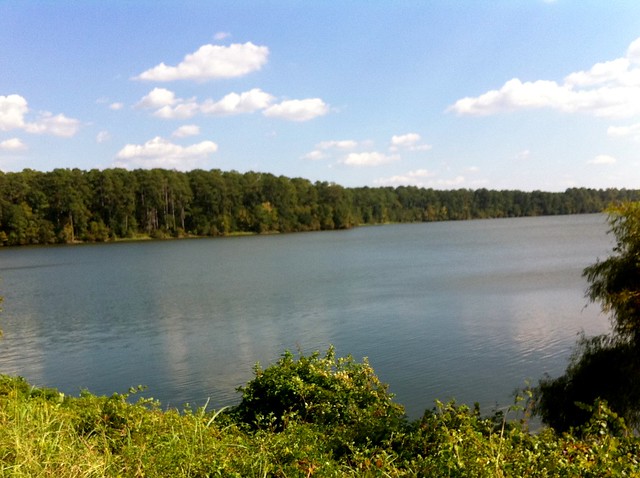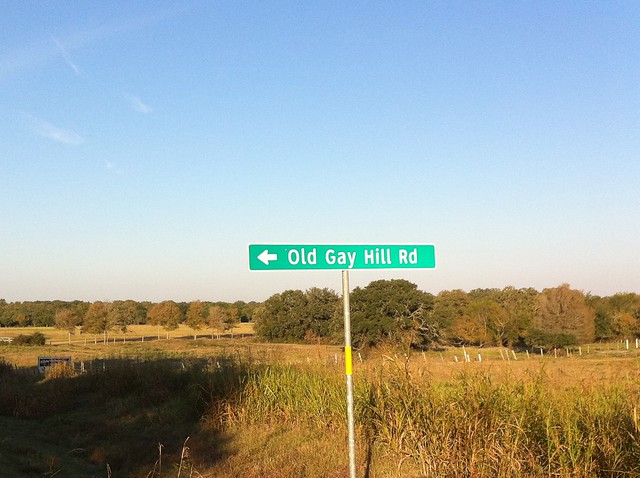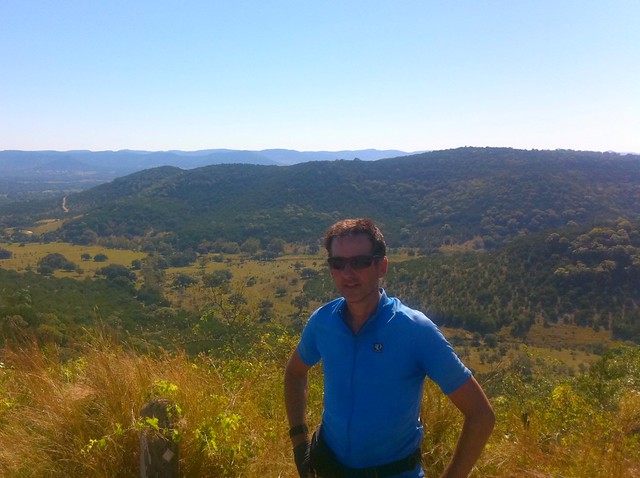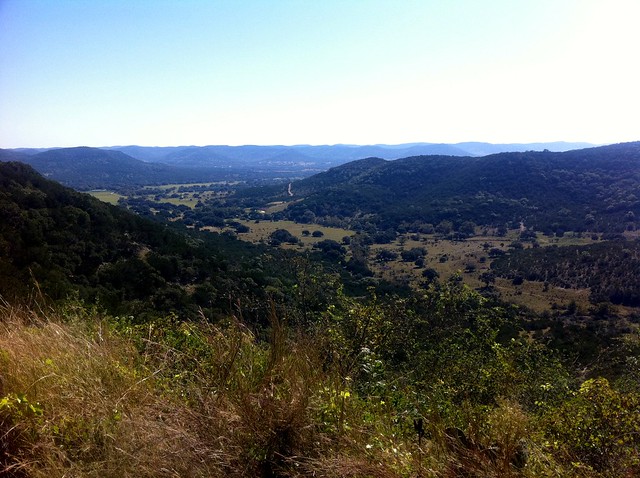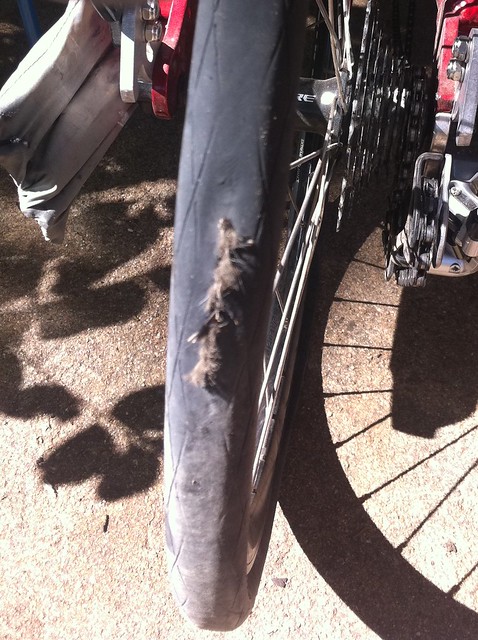A few random comments on how things are going on my tour.
Trike
Since I’ve never done anything quite like this tour before, I don’t have a basis of comparison for how well my recumbent trike works compared to anything else. I had picked the trike because I thought it would carry a load better, and because I expected it would leave me less beat up at the end of a long day.
Before beginning the tour, I rode repeatedly on an out-and-back route out to Bastrop that includes about 10 miles of really bad washboardy chipseal—so 20 miles out-and back. On my racing bike, I can only stand about 10 miles of that road before I feel really beat up. On my trike, I could ride all of that 20 miles (plus the remaining 40) without feeling very beat up at all, so that seemed like a win. Still, I’ve found that riding 100 miles in a day, all on rough roads, leaves me feeling pretty damned beat up. That may be exacerbated by the fact that I’m carrying 26 pounds directly over the rear axle.
Carrying the load directly over the rear axle points to another problem with the trike: torsional stiffness. Most recumbent trikes are built around a large-diameter tube that runs the entire length and serves as the main structural element, and a crossmember running supporting the front wheels. On very uneven surfaces, the rear can be twisting one way while the front is twisting the opposite, and I think this is exacerbated by how the load is carried.
Another negative handling feature that suffers for the same reason is on high-speed descents. Having that load cantilevered out over the rear wheel results in oversteer, which gets scary when descending a mountain pass at 45 mph. Still, I get the impression that I enjoy more stability, and can descend faster, than riders on similarly loaded conventional bikes. These problems could be solved by getting the load forward of the rear axle—as far as I know, no recumbent trike made today really permits this.
I had the trike tuned up right before dismantling it, boxing it, and flying with it to San Diego. By the time I reassembled it there, the brakes were somewhat out of adjustment. Each front wheel is controlled separately, and uneven braking can get a little hairy on twisty descents. I’ve learned to brake only with my inside wheel, which is entirely adequate, but I could imagine a separately controlled rear brake being useful for steep descents.
The seatback on my trike is a heavy mesh that is held in place by webbing straps and buckles, which allow the whole thing to be pulled taut. I think the mesh has permanently deformed, because no matter how tight I pull the straps, I have one vertebra that is hitting one of the buckles; this vertebra (or the soft tissue over it) is tender and visibly swollen. Have inserted some foam between the mesh and buckle.
On many recumbents (including Catrikes), leg length is accommodated by extending or shortening a telescopic boom that carries the crankset. Catrike has keyed the boom to keep the two parts axially aligned, but there’s still a little play. And Catrike’s booms tend to creep down, surprisingly, so I need to readjust the length every few days, and the axial adjustment has a chance to get off each time I do this. I’m pretty sure this resulted in a weird muscle tightness between my calf and ankle on my left leg.
Flats have been something of a problem: I’ve had a total of 8 so far. Having three tracks on the ground inevitably increases the odds of rolling over pointy debris. The fact that my trike uses two different wheels sizes, both rare, makes finding replacement tubes and tires impossible except in a city big enough to support a recumbent dealer. And of course, I shredded my rear tire, which I am choosing to view as a freak occurrence. If one is going to tour on a trike, it would be better to ride one that has 406-mm wheels all around, as they are a pretty common size (BMX bikes use them) and a wider range of tires are available in that size—the 451-mm wheel on the back of my trike limits my tire options severely, mostly to tires not really ideal for touring. I could swap in a 406, but I’m going to stick with what I’ve got. I knew about the wheel-size issue when I bought the trike, so I can’t fault anyone else for it. If I had been as happy with a different trike, I would have chosen a different trike
Despite these complaints, I’m pretty well satisfied with the trike. The trike is an excellent mountain-climber. I would probably have some physical complaints no matter what I rode, and I suspect I have fewer than I would otherwise. In addition to what I mentioned above, I had a calf cramp that lasted a few days and fairly frequent hotfoot, but that’s it. One frequent question I get is whether I’m worried about being invisible so low to the ground—I don’t use a flag. So far it hasn’t really been an issue, but I have to admit it could become one.
the iPhone
I’ve been running my life through my iPhone on tour. I take all my pictures and upload them to flickr with it. I track my daily route with it. I blog with it. I stay in touch via e-mail, twitter, and facebook with it.
Obviously it’s not really built for extended typing, but I’ve been managing to write fairly long blog posts with it, and it hasn’t been too painful. I have more typos, and inserting HTML tags is not worth the trouble (I should probably install a markdown plugin or something), but for my purposes on this tour, it hasn’t been bad. Unfortunately, the WordPress blogging app I use was updated in the middle of my tour, and that introduced some new bugs for me to work around, but it’s working.
For photography, I’ve been using Camera+, which is the best all-in one photo shooting/editing/uploading app I know of, but which has unfortunately has been pulled from the Apple store because they sneakily enabled the use of the volume-up button as a shutter release (a great feature), in violation of Apple’s guidelines. I have my flickr uploads automatically post to my blog as entries through an RSS aggregator plugin. I would prefer something better suited to the job, but haven’t found anything that quite works. I even tried hacking a plugin together myself, but quickly got bogged down.
I log all my rides with Cyclemeter. It’s designed more for fitness riding than touring, but I haven’t found any apps for bike touring that I really like, and I do like Cyclemeter in general. It makes it pretty easy for me to get my tracks into my blog, which is rendered using the XML Google Maps plugin. Anyone who has been reading this blog has noticed some crazy data in those tracks. This isn’t really Cyclemeter’s fault—it relies on the Location Services API from the iPhone for the raw data. I can imagine some workarounds.
I’m using the official Twitter iPhone app, and pulling in my tweets to my blog; I’ve used both an RSS aggregator plugin and the Twitter Tools plugin. The latter formats the posts better, but has had authentication issues with Twitter.
Other stuff
The rest of my gear has worked fine. The Ortlieb Sport Packer panniers are well-constructed and mount securely. The one ding against them is that each pannier is just one big bag, so it’s not easy to get at more than one thing in each pannier. Additional pockets would increase cost and be difficult to rainproof, and so would be a tradeoff. The solar panel I’ve been using to recharge batteries has worked fine. I bought a pair of REI climbing shorts and a pair of REI convertible pants to bring as street clothes; the shorts are fine, but the convertible pants are great—I should have bought two pair of those. Super-light, well-constructed, and about a dozen pockets. My Nike cycling cleats are starting to disintegrate: the velcro is only glued onto the top straps; one piece of velcro has come off entirely (I reglued it while in Phoenix) and the others have loose edges.
I’ve brought two pair of cycling shorts—some Castelli Endurance bib shorts, and some Louis Garneau bib shorts (not sure of the model). The Castellis are pretty fancy. They’re made of very light fabric, which is nice because when I rinse them out and wring them out at the end of each day (protip: to wring out lycra, roll it up in a towel and wring out the towel—it extracts more water), they’re always dry by the next morning, but it also means they’re visibly disintegrating. The Louis Garneaus are heavier material that is always a little damp in the morning but will probably wear better. I’ve also brought two jerseys—an ancient Assos jersey and an old Pearl Izumi. Apart from the fact that both have tar stuck to the back that will never come off, they’re fine. I’ve been carrying my phone, ID, and money in an Amphipod waist pouch that works fine. I had contemplated getting a bike mount for the phone, but I now think the constant road vibrations would have either shaken the phone loose or damaged it if I used one.
I haven’t used my camping gear much, but it’s fine, as far as it goes. I have a problem getting a good night’s sleep when the small of my back is unsupported, and my sleeping pad just isn’t fat enough to offer that support. It’s a funny thing: if I knew that I could get a meal and a place to sleep every day, I could be doing this tour with about one-quarter the amount of gear. That insurance policy is heavy.
The weather has been changing during the tour, and for the remainder, I’ll be bringing a cool-weather jersey and tights. Other than that, I’ve felt adequately equipped.
My health
I’ve already mentioned some minor biomechanical issues that relate to my equipment. Other than that, I’ve had few complaints. I’ve mostly managed to avoid sunburn except for my lips: I carry SPF 30 chapstick, but even with frequent applications, my lips have gotten pretty torn up. I developed a mysterious rash on my left shoulderblade that lasted a couple of days and seems to be gone now. I got some bug bites (fleas? bedbugs?) early in the tour.
I’ve been hydrating adequately, but I haven’t been eating enough. I lost at least 10 lb (I’ve been eating like a horse while home). It’s hard to get enough calories in a day, especially from decent-quality food.
On most days, my distance is limited not by my abilities but by the amount of daylight and the locations of town: one of my rules is to avoid riding in the dark, another is to end each day in a town. I’ve been pacing myself pretty well. My legs usually have some life left in them, even after 100 miles, although I’m slow rolling out in the morning.
Other observations
Bikers seem to be uniformly friendly, and I’ve had several nice chats with Harley riders pulled over on the shoulder. Semi drivers are pretty friendly too. New Mexico drivers almost always wave.
Riding in a car after 20 days of cycling is weird. The comfort, the quiet, and the speed—covering in one hour a distance that would be a respectable day’s riding is kind of mind-boggling.
